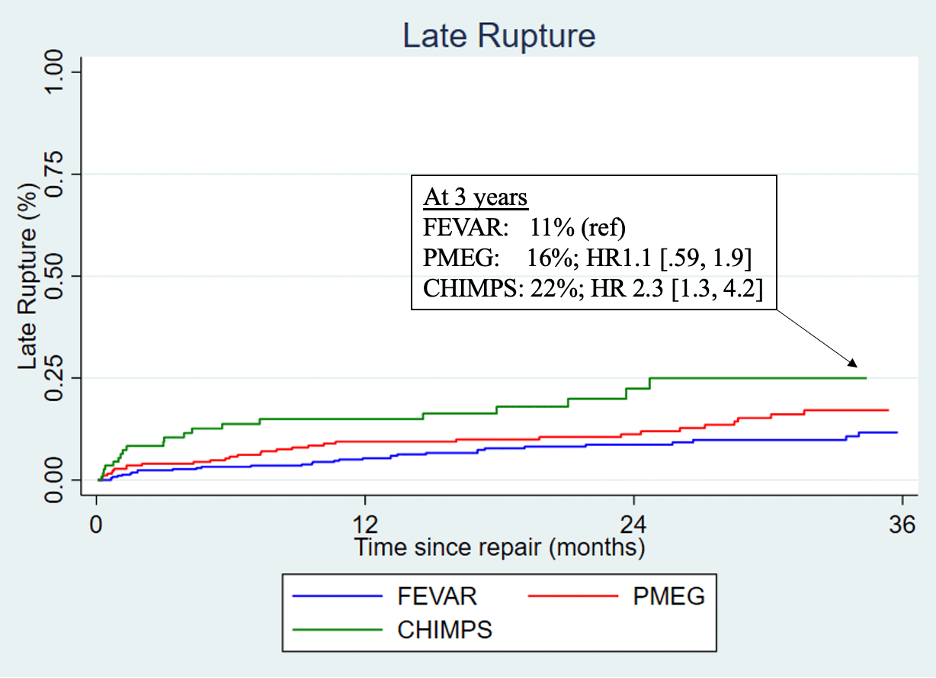Postoperative And 3-year Outcomes Following Endovascular Repair Of Complex Aortic Aneurysms In The Vascular Quality Initiative
Priya B. Patel, MD, MPH, Thomas F.X. O'Donnell, MD, Christina L. Marcaccio, MD, MPH, Vinamr Rastogi, Virendra I. Patel, MD MPH, Sara Zettervall, MD, Marc L. Schermerhorn, MD.
Beth Israel Deaconess Medical Center, Boston, MA, USA.
OBJECTIVES: Advances in endovascular technology allow for minimally invasive repair options for complex aortic aneurysms (cAAA), but direct comparisons are limited. Therefore, we compared postoperative and 3-year outcomes following cAAA repair by endovascular treatment type.
METHODS: We identified all endovascular repairs of cAAA in the VQI from 2014-2017 with linkage to Medicare claims through 2018 for long-term outcomes. Repairs included all commercially available fenestrated endovascular aneurysm repairs (FEVAR), chimney/parallel/snorkel repairs (CHIMPS), and physician-modified endografts (PMEGs), exclusive of investigational device exemptions. Postoperative morbidity and mortality were assessed using logistic regression. Three-year all-cause mortality, late rupture, and late reinterventions were assessed using Kaplan Meier methods and Cox regression.
RESULTS: There were 393 FEVAR, 291 PMEG, and 160 CHIMPS. CHIMPS was more often used for urgent repair (FEVAR:1.1%, PMEG:9.3%, CHIMPS:23%, P<.001). Among elective repairs, PMEGs were employed in the most extensive aneurysms (Crawford Type 1-3: FEVAR:0%, PMEG:38%, CHIMPS:19%, P<.001), more often incorporated branch vessels (FEVAR:2.4 ±.66, PMEG:3.4 ±.81, CHIMPS:2.1 ±1.0, P<.001), and were more often used in patients with prior aortic aneurysm repair (FEVAR:6.9%, PMEG:33%, CHIMPS:24%, P<.001). After adjustment with FEVAR as the reference group, rates of postoperative spinal ischemia, stroke, and acute kidney injury were similar across groups. However, CHIMPS was associated with higher odds of postoperative mortality (OR 2.7; 95%CI [1.1-6.9]). CHIMPS had the highest estimated 3-year mortality (FEVAR:14%, PMEG:17%, CHIMPS:28%, log-rank P<.001), and late rupture (FEVAR:11%, PMEG:16%, CHIMPS:22%, log-rank P=.004), while PMEGs had the highest estimated rate of late reinterventions (FEVAR:29%, PMEG:34%, CHIMPS:22%, log-rank P=.007). After adjustment, 3-year mortality was similar across groups (PMEG: HR .79 [.47-1.3]; CHIMPS: HR 1.5 [.92-2.4]) as was late reintervention (PMEG: HR 1.3 [.86-2.0]; CHIMPS: HR 1.1 [.61-1.9]). However, CHIMPS remained independently associated with higher risk of late rupture (PMEG: HR 1.1 [.59-1.9]; CHIMPS: HR 2.3 [1.3-4.2]; P=.006). (Figure) CONCLUSIONS: In patients undergoing endovascular repair of cAAA, CHIMPS was associated with higher rates of post-operative mortality and 3-year late rupture. These results call into question the durability of parallel grafting, and suggest that branched/fenestrated repair should be used whenever feasible. 
Back to 2022 Abstracts
